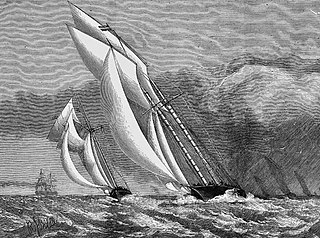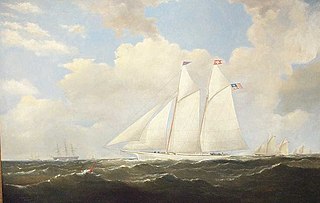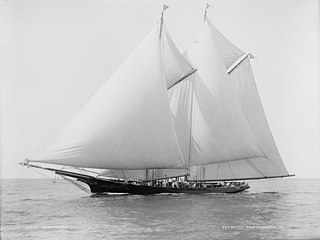
James Gordon Bennett Jr. was publisher of the New York Herald, founded by his father, James Gordon Bennett Sr. (1795–1872), who emigrated from Scotland. He was generally known as Gordon Bennett to distinguish him from his father. Among his many sports-related accomplishments he organized both the first polo match and the first tennis match in the United States, and he personally won the first trans-oceanic yacht race. He sponsored explorers including Henry Morton Stanley's trip to Africa to find David Livingstone, and the ill-fated USS Jeannette attempt on the North Pole.

The New York Yacht Club (NYYC) is a private social club and yacht club based in New York City and Newport, Rhode Island. It was founded in 1844 by nine prominent sportsmen. The members have contributed to the sport of yachting and yacht design. As of 2001, the organization was reported to have about 3,000 members. Membership in the club is by invitation only. Its officers include a commodore, vice-commodore, rear-commodore, secretary and treasurer.

Columbia was one of the two yachts to successfully defend the second America's Cup race in 1871 against English challenger Livonia.

USS Hope was a 19th-century wooden yacht schooner, designed and built in 1861 by Henry Steers for Captain Thomas B. Ives of Providence, Rhode Island. She was acquired by the Union Navy during the American Civil War. She was placed into service as a gunboat assigned to support the fleet blockading the ports of the Confederate States of America. However, at times, Hope was assigned extra tasks, such as that of a dispatch boat, supply runner and salvage ship. She was a pilot boat from 1866 to 1891 and in 1891 she was replaced by the Herman Oelrichs, when the Hope was wrecked ashore the Sandy Hook Point.

Robert "Bob" Fish was known as the oldest and most successful of the 19th-century American yacht modelers and shipbuilders. He was well known for remodeling of the Sappho that won 3 successive international races.

The Enchantress was a 19th-century racing yacht, winner of several national and international Cups including the Royal Yacht Squadron's 53-mile (85 km) regatta around the Le Havre to Southampton, and the New York Yacht Club's 140-mile (230 km) regatta from Owl's Head Point to Sandy Hook Lightship. She was designed by Robert Fish for George L. Lorillard.

The Widgeon was a 19th-century yacht and Sandy Hook pilot boat, built in 1855 by James R. & George Steers for Daniel Edgar of the New York Yacht Club and designed by George Steers. She came in 17th in an unsuccessful America’s Cup defense in 1870. Widgeon was sold in 1871 to a group of New York pilots to replace the John D. Jones, which sank in a collision with the steamer City of Washington. New York pilots condemned the Widgeon as unseaworthy in 1879, which sparked a fight for steam pilot-boat service. In 1883 a decision was affirmed by the Supreme Court and the Board of Commissioners of Pilots that pilot boats could be "propelled" by steam.

Captain Samuel S. Samuels was a 19th-century American sea captain best known for command of the famous clipper ship the Dreadnought. The fastest sailing ship of the time was quite famous and Captain Samuels was also renowned as the captain and designer of the ship. In 1859 he set a new record for New York to Liverpool of only 9 days, 17 hours. Twice Captain Samuels sailed faster than steamer ships which were increasingly popular for freight during this time.

The Magic was a racing schooner yacht, of the New York Yacht Club. She was the first American defender during the 1870 America's Cup hosted in New York against the 1st British challenger Cambria, representing the Royal Thames Yacht Club of London. The Magic, had 19 owners. Her last owner modified her into a pilot boat at Key West. In 1922, during a hurricane, she was wrecked on the beach in Key West.

David Carll was a 19th-century American shipbuilder. He was well known for building fast and seaworthy yachts and schooners. He specialized in shallow draft Centreboard schooners. The David Carll's shipyard was the first commercial shipyard built in City Island. He built the popular schooners David Carll, Vesta,Resolute, and Ambassadress. His brother, Jesse Carll had a successful shipyard in Northport, New York.

The Fleur de Lis was a 19th-century yacht and pilot boat built in 1865 by J. B. Van Deusen for Captain John S. Dickerson of the New York Yacht Club. She was bought by pilot Franklin B. Wellock and became the Boston pilot boat No. 7. She was known as one of the best pilot boats in the Boston harbor. By 1904, the pilot boat Fleur de Lis was lying in a graveyard for old boats in East Boston.

The Gracie was a 19th-century racing sloop yacht built in 1868 by James E. Smith shipyard at Nyack, New York. She raced the America's Cup defender Mischief in the trails off Sandy Hook in 1881. Gracie raced at the New York Yacht Club, Atlantic Yacht Club and other eastern yacht clubs. After a 42-year career in racing, she was sold in 1909 and converted to a freight boat sailing from Milton Point, off Long Island to New York.
J.B & J.D. Van Deusen was a 19th-century American shipbuilding company started by Joseph B. Van Deusen and James D. Van Deusen in 1865. The shipyard was in Williamsburg, Brooklyn. Some of the finest yachts, schooners and steamboats in the New York were designed and built by them. The last boat that was built at the shipyard was the schooner-yacht Mohawk in 1875, which was later renamed Eagre and transferred to the United States Navy in 1903.

Andrew Jackson Comstock was a 19th-century maritime pilot. He was one of the most experienced yachtsman having sailed for more than 27 years. He was known for being the captain of the racing yachts Columbia and Magic that won races for the America's Cup.

Franklin Osgood was a 19th-century businessman and yachtsman. He was one of the most experienced yachtsman having sailed for more than 23 years. He was owner and manager of the racing yachts Widgeon, Columbia, and Magic. He was the first defender and two-time winner of the America's Cup. Osgood was inducted into the America's Cup Hall of Fame in 2020.

Henrietta was a 19th-century wooden yacht schooner, designed and built in 1861 by Henry Steers for James Gordon Bennett Jr. She was acquired by the Union Navy during the American Civil War. She was placed into the U.S. Revenue Service assigned to support the fleet blockading the ports of the Confederate States of America. The Henrietta won the first mid-winter transatlantic yacht race across the Atlantic between three American yachts.

The Dauntless was a 19th-century wooden yacht schooner, designed and built in 1866 by Forsyth & Morgan at Mystic Bridge, Connecticut, and owned and sailed by noted yachtsmen, among them James Gordon Bennett Jr. and Caldwell Hart Colt. She was first called the L'Hirondelle and later renamed the Dauntless. The Dauntless was in three Trans-Atlantic matches for the New York Yacht Club. She came in fourth in an unsuccessful America’s Cup defense in 1870.

The Phantom was a 19th-century centerboard schooner-yacht built in 1865 by Joseph D. Van Deusen and first owned by yachtsman Henry G. Stebbins. She was one of the fastest yachts in the New York squadron. The Phantom won 1st place in the June 1867 New York Yacht Club regatta. She came in 7th place in an unsuccessful America's Cup defense in 1870. She was sold as a racing yacht several times before she went out of service in 1900.

The Idler was a 19th-century schooner-yacht built in 1864 by Samuel Hartt Pook from Fairhaven, Connecticut, and owned by yachtsman Thomas C. Durant. She was one of the fastest yachts in the New York squadron. Idler came in 2nd place in the America’s Cup defense in 1870. She was sold as a racing yacht several times before she capsized and sank in 1900.

The Madeleine was a 19th-century racing schooner-yacht built in 1868 by David Kurby in Rye, New York and owned by Commodore Jacob B. Voorhis. Madeleine was the winner of the America's Cup in 1876 and an American defender in the 1870 America's Cup. She won the two most desired trophies reserved for schooners, the Bennett and the Douglas Cups. In 1911, the Madeleine was dismantled and sunk at the mouth of the Hillsborough River, Florida.





















